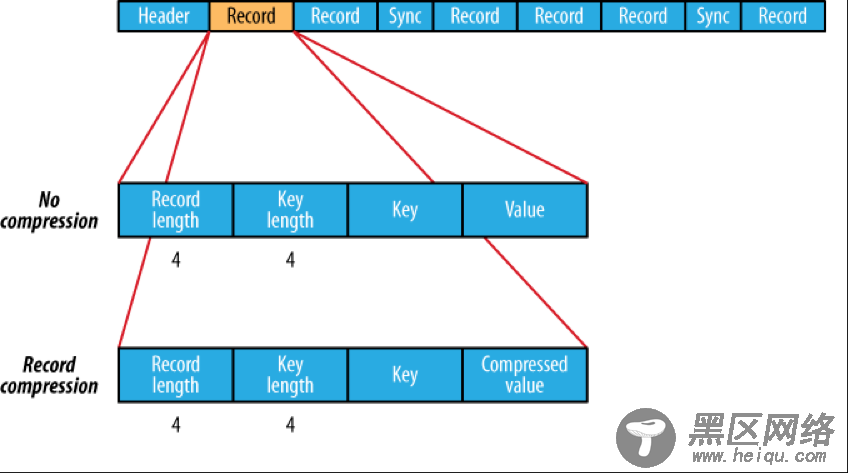基于文件的数据结构
两种文件格式:
1、SequenceFile
2、MapFile
SequenceFile
1、SequenceFile文件是Hadoop用来存储二进制形式的<key,value>对而设计的一种平面文件(Flat File)。
2、可以把SequenceFile当做一个容器,把所有文件打包到SequenceFile类中可以高效的对小文件进行存储和处理。
3、SequenceFile文件并不按照其存储的key进行排序存储,SequenceFile的内部类Writer**提供了append功能**。
4、SequenceFile中的key和value可以是任意类型Writable或者是自定义Writable类型。
SequenceFile压缩
1、SequenceFile的内部格式取决于是否启用压缩,如果是,要么是记录压缩,要么是块压缩。
2、三种类型:
A.无压缩类型:如果没有启用压缩(默认设置),那么每个记录就由它的记录长度(字节数)、键的长度,键和值组成。长度字段为四字节。
B.记录压缩类型:记录压缩格式与无压缩格式基本相同,不同的是值字节是用定义在头部的编码器来压缩。注意,键是不压缩的。
C.块压缩类型:块压缩一次压缩多个记录,因此它比记录压缩更紧凑,而且一般优先选择。当记录的字节数达到最小大小,才会添加到块。该最小值由io.seqfile.compress.blocksize中的属性定义。默认值是1000000字节。格式为记录数、键长度、键、值长度、值。
无压缩格式与记录压缩格式

块压缩格式

SequenceFile文件格式的好处:
A.支持基于记录(Record)或块(Block)的数据压缩。
B.支持splittable,能够作为MapReduce的输入分片。
C.修改简单:主要负责修改相应的业务逻辑,而不用考虑具体的存储格式。
SequenceFile文件格式的坏处:
坏处是需要一个合并文件的过程,且合并后的文件将不方便查看。因为它是二进制文件。
读写SequenceFile
写过程:
1)创建Configuration
2)获取FileSystem
3)创建文件输出路径Path
4)调用SequenceFile.createWriter得到SequenceFile.Writer对象
5)调用SequenceFile.Writer.append追加写入文件
6)关闭流
读过程:
1)创建Configuration
2)获取FileSystem
3)创建文件输出路径Path
4)new一个SequenceFile.Reader进行读取
5)得到keyClass和valueClass
6)关闭流
org.apache.hadoop.io
Class SequenceFile
There are three SequenceFile Writers based on the SequenceFile.CompressionType used to compress key/value pairs:
1、Writer : Uncompressed records.
2、RecordCompressWriter : Record-compressed files, only compress values.
3、BlockCompressWriter : Block-compressed files, both keys & values are collected in 'blocks' separately and compressed. The size of the 'block' is configurable1
无压缩方式、记录压缩、块压缩实例
package SequenceFile;
import java.io.IOException;
import java.net.URI;
import org.apache.hadoop.conf.Configuration;
import org.apache.hadoop.fs.FileSystem;
import org.apache.hadoop.fs.Path;
import org.apache.hadoop.io.IOUtils;
import org.apache.hadoop.io.IntWritable;
import org.apache.hadoop.io.SequenceFile;
import org.apache.hadoop.io.SequenceFile.CompressionType;
import org.apache.hadoop.io.Text;
import org.apache.hadoop.io.Writable;
import org.apache.hadoop.io.compress.BZip2Codec;
import org.apache.hadoop.util.ReflectionUtils;
public class Demo01 {
final static String uri= "hdfs://liguodong:8020/liguodong";
final static String[] data = {
"apache,software","chinese,good","james,NBA","index,pass"
};
public static void main(String[] args) throws IOException {
//1
Configuration configuration = new Configuration();
//2
FileSystem fs = FileSystem.get(URI.create(uri),configuration);
//3
Path path = new Path("/tmp.seq");
write(fs,configuration,path);
read(fs,configuration,path);
}
public static void write(FileSystem fs,Configuration configuration,Path path) throws IOException{
//4
IntWritable key = new IntWritable();
Text value = new Text();
//无压缩
/*@SuppressWarnings("deprecation")
SequenceFile.Writer writer = SequenceFile.createWriter
(fs,configuration,path,key.getClass(),value.getClass());*/
//记录压缩
@SuppressWarnings("deprecation")
SequenceFile.Writer writer = SequenceFile.createWriter
(fs,configuration,path,key.getClass(),
value.getClass(),CompressionType.RECORD,new BZip2Codec());
//块压缩
/*@SuppressWarnings("deprecation")
SequenceFile.Writer writer = SequenceFile.createWriter
(fs,configuration,path,key.getClass(),
value.getClass(),CompressionType.BLOCK,new BZip2Codec());*/

